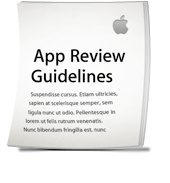Apple Moves The Goal Posts For Developers (again)
 Ben Harvell is a freelance writer and former editor of iCreate magazine. He now writes for a wide range of international technology magazines and websites including Macworld and MacFormat. He has written several books on consumer technology and blogs at benharvell.com. Ben covered the launch of the iPhone in 2007 and has been closely associated with the device and it’s rivals ever since. He has commissioned his own apps and reviews App Store content on a regular basis. He’s also rather obsessed with Twitter.
Ben Harvell is a freelance writer and former editor of iCreate magazine. He now writes for a wide range of international technology magazines and websites including Macworld and MacFormat. He has written several books on consumer technology and blogs at benharvell.com. Ben covered the launch of the iPhone in 2007 and has been closely associated with the device and it’s rivals ever since. He has commissioned his own apps and reviews App Store content on a regular basis. He’s also rather obsessed with Twitter.
Apple might think it has the right, being (in its eyes) the inventor of the modern mobile app store, but does that mean it should be allowed to make up the rules as it goes along? It all started with the launch of the iPhone. For a while there was complete dismissal from Apple of the idea of third-party apps ever being made available for the device. “You don’t want your phone to be like a PC” said Steve Jobs talking to the New York Times in 2007, followed by “These are more like iPods than they are like computers.”
It seems likely that the app idea was planned all along rather than Apple just blindly stumbling into the market as it would have you believe, but when the App Store finally arrived we entered a whole new realm of controversy, prefaced by Jobs in the same interview:
“It has to be more of a controlled environment”.
And controlled it was. It started with the simple “No porn”. Then we moved on to “No farts”. Then we went back to “Okay, you can have farts, just make them useful”. Then we had “no third-party compilers”. Now it’s okay to use Adobe’s tools again.
This week its subscriptions. Yes, you can have them but only if you offer the same subscription deal (a deal you’ve probably been running successfully for the life of your product and years before the iPhone) inside the app as you do outside it. You also can’t bounce users out to a subscription page on the web, which is great from a user experience perspective but also a really tasty prospect for Apple. Why? It’s that magic 30% cut again, of course.
Apple saw subscriptions, which apply to content-based apps like magazines and eBook readers, as a gushing torrent of potential income that it didn’t have a tap on. Like In-App Purchases before it, the new subscriptions “service” gives Apple more control and basically says to content providers “Don’t think you’re going to find ways to make money through your app without giving us our piece of the pie”.
It’s like Apple sees any skirting of its holy (or should that be “holey”) App Store commandments as a personal slight. This point is further illustrated in its updated App Store Review Guidelines that now cover “cheating the system”. It provides the example of stealing data and manipulating ratings as reasons for such a tweak but it also opens Apple’s options in the future for flat out bans on developers who find clever ways to circumvent its demands.
The App Store Review Guidelines are, according to Apple, part of a “living document” which, loosely translated, means “disconcertingly vague and liable to change at a moment’s notice”. Every time Apple shifts its stance it does so with a backdrop of reasoning. Subscriptions arrive in time to point toward the “innovative” work of The Daily in the subs field rather than how it screws over Amazon. Adjusting the review guidelines is proposed as a counter to malicious apps, not a way to punish developers not prepared to pay the piper.
None of Apple’s App Store adjustments, however, include the line “this change will also make us heaps more cash”.
P.S.: If you think I’m being unfairly harsh on Apple, especially in light of the widely reported news on Steve Jobs today, I’m talking about the company as a whole. For my thoughts on The National Enquirer’s pictures, click here





 Amazone
Amazone 